DRIFTLESS - Over the past week COVID-19 diagnoses statewide increased from 28,058 June 29 to 32,061 Monday, July 6. That is a statewide increase of 4,003 cases. The number of deaths increased from 777 to 796, an additional 19 deaths, according to the state Department of Health Services. Of the 254 patients currently hospitalized with confirmed COVID-19 cases, 66 are in intensive care. The U.S. death toll passed 132,000 on Monday.
During the holiday weekend, the state set another single-day record for new cases. All told, there were 1,744 new COVID-19 cases reported over the three days by the state Dept. of Health Services.During the span of days, the positivity rate hovered around 10 percent of all daily tests processed. On Monday, 484 newly confirmed cases made up 9.2 percent of 5,286 total tests.
Testing and immunity
American Red Cross is offering a free antibody test to individuals who donate blood. Antibody tests will tell you if you have already had the virus. These are different than the tests being administered across the state in communities, which will tell you if you currently have the virus.
It is not a “safe bet” to rely on immunity to COVID-19 as a strategy for coping with the pandemic, one expert has warned, adding that herd immunity strategies were “probably never going to work.”
Danny Altmann, professor of immunology at Imperial College London, said that in towns and cities where there had been coronavirus infections, only 10-15 percent of the population was likely to be immune.
“And immunity to this thing looks rather fragile — it looks like some people might have antibodies for a few months and then it might wane, so it’s not looking like a safe bet,” he said. “It’s a very deceitful virus and immunity to it is very confusing and rather short-lived.”


Crawford Countysaw eight new cases, increasing to 41. The number of negative tests increased by 168, and there have been no deaths in the county. Prairie du Chien has 18 cases, central Crawford County has seven cases, and southern Crawford County has six cases.
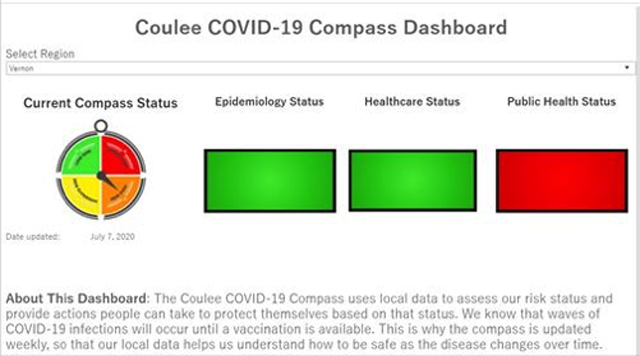
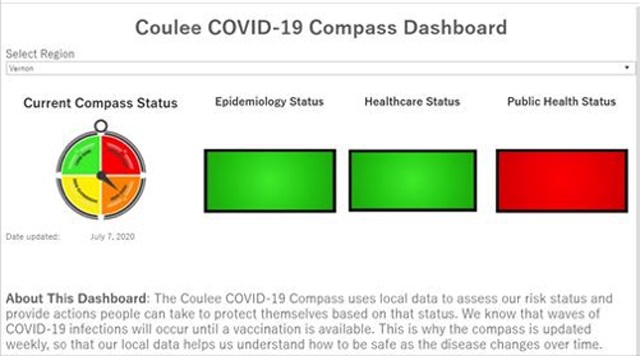
Vernon Countysaw an increase of three cases in the last week, increasing to 38. The number of negative tests increased by 345, and there have been no deaths.
Richland Countysaw no increase in cases, remaining at 15. The number of negative tests increased by 159, and the number of deaths in the county remained at four. Southern Richland County has six cases.
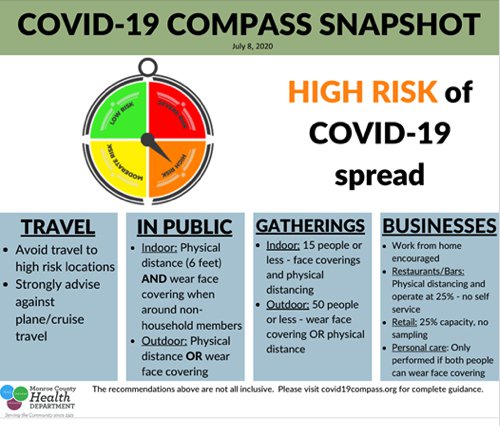
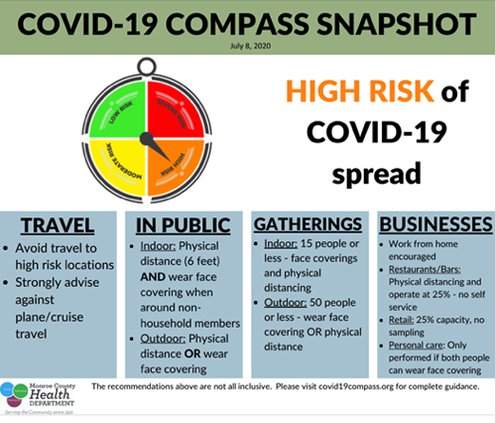
Monroe Countysaw an increase of 30 cases in the last week, going from 65 to 95. Negative tests increased by 320, and the number of deaths in the county remains at one.
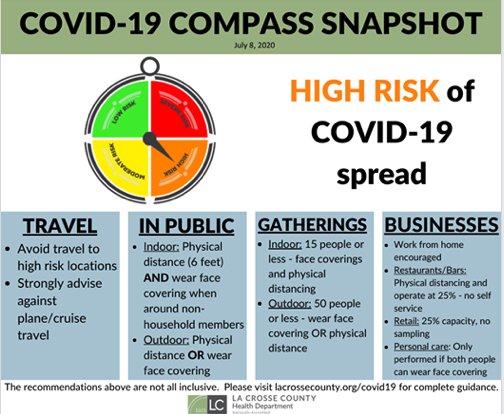

LaCrosse Countyhas seen an exponential increase in new cases in the last week of 81, going from 428 to 509. There have been no deaths in the county.
The increasing number of cases of COVID-19 has prompted the La Crosse County Health Department to establish a dedicated page on the COVID-19 website to notify the public of locations where risk of exposure to the virus has occurred.
It can be found at www.lacrossecounty.org/covid19 on the Outbreaks and Investigations page.
You can see current guidance on the Coulee COVID-19 Compass at https://lacrossecounty.org/covid19compass.
The La Crosse County Health Department (LCHD) also announced a streamlined process to notify businesses being added to the Outbreak and Investigation page at www.lacrossecounty.org/covid19. This page is a resource for the public to understand the risk for all known places within La Crosse County that the La Crosse County Health Department knows to have had lab-confirmed COVID-19 exposures in the last two weeks.
The purpose of this process is to work proactively with businesses to prevent community and worksite exposure to COVID 19.
Businesses determined to have continued high risk of exposure will remain on the page until 14 days after the last known positive case was present. The Outbreak and Investigation page will be updated every weekday by 4 p.m.
Grant Countyhas seen an increase of 24 cases in the last week, going from 154 to 178. There was one additional death, with the number increasing to 13.
According to DHS’ census-level map, all of Grant County’s census tracts have at least five cases, led by Platteville, with 37 cases. The census tract that approximately includes the towns of Clifton, Ellenboro, Liberty, Lima and South Lancaster, with 30 cases and 12 deaths. Lancaster has 19 cases. The census tract that includes Cuba City, Dickeyville and Smelser has 16 cases. The Hazel Green and Jamestown area has 32 cases, and the census tract that includes Cassville, Beetown, Glen Haven, Waterloo and North Lancaster has eight cases. The Fennimore, Mount Ida and Marion area has seven cases. Northwestern Grant County and northeastern Grant County have five cases each.
Lafayette Countyhas seen an increase of three cases in the last week, going from 72 to 75. There have been no deaths in the county.
Iowa Countyhas seen an increase of six cases in the last week, increasing to 37. There have been no deaths in the county.
Platteville Journal editor Steve Prestegard contributed to this story.
CDC investigation
By MADELINE HEIM
The Post-Crescent
Researchers from the Centers for Disease Control in Atlanta arrived in Winnebago County on Monday to investigate a problem that's now replicating itself across the nation: Since June 1, nearly three-fifths of the area's new coronavirus cases have been people in their 20s.
At the end of May, county health officials started to see a worrying trend that turned into the sixth-fastest growing outbreak in the nation. Cases tripled in a matter of weeks, and young people were behind much of that growth.
The CDC team, which will be in Winnebago County through at least July 7, plans to help investigate some of the social factors driving young people to get together and risk infection.
"It may be difficult for us to stop," county health officer Doug Gieryn said Tuesday. "We really want to get a better handle on this before school starts in the fall."
And he's not alone.
Wisconsin residents in their 20s are testing positive for the coronavirus nearly twice as often in the last 10 days as they were in the 50 days before that. Data from the Department of Health Services show that before June 22, this age group made up about 20 percent of the state's total positive tests. Since then, they've made up 40 percent.
Wisconsin hasn't seen a major surge like other U.S. states, like in the South. But daily case totals in the state are growing. The seven-day average of new cases has grown from under 270 in mid-June to 475 on Tuesday, and the percentage of tests that return positive has been climbing along with it.
"It's been, for some people, three months or longer of being very careful," said UW-Madison epidemiologist Patrick Remington. "People are letting their guard down.
The question is, where is the disease being spread? And why are 20-somethings bearing the brunt of new cases?
Are protests driving coronavirus growth? It doesn't seem so.
As mass gatherings have unfolded in Madison, Milwaukee and dozens of other municipalities across Wisconsin to protest the death of George Floyd and police brutality against Black people, some might think the answer to where more people are getting infected is clear.
But a new working paper from the National Bureau of Economic Research and the Center for Health Economics and Policy Studies at San Diego State University suggests that's not the case.
Researchers found no evidence that COVID-19 transmission had overall increased in the weeks following protests in 315 large U.S. cities.
It's possible that there was an increase in spread among those who attended the protests, they wrote, but protests may have made others more reluctant to leave their homes.
If the protests are perceived to be dangerous (because of property destruction, violent response from police or potential for infection), that can cause people who do not attend to increase their social distancing and sheltering-at-home behaviors, said Dhaval Dave, a professor of economics at Bentley University in Massachusetts and co-author of the study.
But even rates of infection among protesters who got tested in pop-up clinics is proving to be low, Dave said, suggesting that many are using effective protective measures like wearing masks and attempting to social distance as much as a person is able.
"What our findings suggest is (gatherings) do not necessarily have to mean an increase in infection rate, if the people in that population continue to be cognizant of the risk," Dave said.
As quarantine fatigue sets in, officials worry about packed bars
If protests share little of the blame for the surge in cases, the reopening of bars and other popular gathering places may be a different story.
We know now how and when the virus spreads: close, sustained contact with an infected individual, particularly indoors, particularly if a person coughs, sneezes, shouts or sings. When the state shut down for a month and a half, that naturally happened less. But now, things are different.
In La Crosse County, where a recent surge in cases has been roughly half people in their 20s, the health department released a list of establishments where an infected person had been, including several downtown bars. Other restaurants in the area have temporarily re-closed, according to the La Crosse Tribune.
Dane County public health leaders ordered bars closed and restaurants to limit indoor dining to 25 percent capacity to help curb a recent spike in cases. In their weekly data snapshot, they reported that 49 percent of the county's 614 new cases in the last week were between the ages of 18 and 25, and 45 percent of the people interviewed said they attended a gathering or party with people outside their household.
On Monday, UW Health Chief Quality and Safety Officer Jeff Pothof said contact tracers are finding that a high percentage of newly infected people have been in large gatherings at bars and taverns.
Further data analysis in Winnebago County found it wasn't just 20-somethings, but 19- to 23-year-olds, in particular, who were driving the county's spike.
Gieryn, the county health officer, visited service industry establishments where younger people are more likely to congregate and work, and even went to a Tavern League meeting to ask for their help.
Though their new case rate has dropped, Gieryn is still concerned that busy establishments reopening, coupled with young people being more likely to take risks, will be a problem for his community.
Brown County officials also sounded the alarm about people ages 21 through 30, saying they need to play a bigger role in stopping the spread.
"We get a confirmed case and we're asking, well, what were you doing? And what we’re learning is, 'Well, I had a wedding, I went to a bar, I went to a restaurant, I went to a graduation party, I went to a gathering at my family’s house," county Health Officer Anna Destree said on a call with reporters Monday.
Consider the true risk of being infected with the coronavirus, experts say
Along with feeling quarantine fatigue, Remington said, young people have always been and will continue to be more inclined to take a risk. And because early data has shown young people are less likely to die of COVID-19 — in Wisconsin, for example, people ages 20-29 account for just one percent of the state's death count — people believe it's worth the risk now in exchange for some social interaction.
The problem with that attitude is two-fold: First, although young people are less likely to get seriously ill, some still will, and some will die, Remington said.
More serious illness and death typically lags a few weeks behind initial spikes. But from June 21 to this Monday, for example, 27 more people in their 20s were hospitalized with the virus, two more were in the intensive care unit and one more died, according to DHS data.
Second, a person risks transferring the virus to someone who is more susceptible to serious consequences.
"You've got to realize that someone gave you that virus and chances are you're going to give it to somebody else," Remington said. "Your individual behavior is harming others. You're now a step in the epidemic in a community."
A county health department in Washington state found 14 cases associated with a large party someone had thrown in early June, which led to 15 more cases related to those 14 — which then spread to 31 employers as infected people went in to work.
With the CDC team in Winnebago County, Gieryn is trying to make another message clear as well: Especially in the fall, as students return to UW-Oshkosh with the potential to pack full bars and house parties, he wants them to understand just how much we don't know about the virus yet.
Even the people who contracted it first have only been living with it for six months. In comparison to what we know about diseases that have been with us for decades, that's not much time to assess what effects it could have on young people in the long run, even if their initial illness is mild.
"It's still far better to avoid this illness if you can," Gieryn said. "Until we learn more, it may not be as absent-of-risk for young persons as they feel it is."
Risky behavior from young people only tells part of the story
Easy as it may be to pass judgment on young people partying and socializing, Remington cautioned that for every patron, there are employees on the other side of the bar who need to go back to work to make money.
And as the protest researchers cautioned, the small and visible minority — say, the long line of college-age people standing outside the Kollege Klub in Madison — don't represent the full group's intentions.
That's true for Maryellen Pawley and her boyfriend CJ Zabat, both 23 and living in Madison. The pair will soon be leaving the city they've called home for the last several years, she for graduate school at Harvard University and he for a stint driving the Oscar Mayer Wienermobile across the country.
Although still avoiding bars and restaurants and limiting meet-ups to socially distanced small groups, they will host a larger gathering at a park prior to leaving, Pawley said. She's requiring everyone wear masks, stay six feet apart and bring their own food and drink.
"We are doing what we can to stay safe, but in our circumstances we are also trying to say goodbye and move away from the last five years of our lives with at least some closure," she said.
In Green Bay, 28-year-old Autumn Siudzinski's plans after graduating from a master's program were tanked when the coronavirus hit: the ceremony, a party with friends and family and an ensuing trip to Europe all had to be canceled.
Since then, she's turned down other invitations, like one to a birthday party at a restaurant, and tried to keep her gatherings small and outdoors. She ate on an outdoor patio once with her parents, but said she has otherwise avoided bars and restaurants.
"It kind of feels pointless to have canceled (my graduation plans) to help protect people and then head out in a group of people — like what was the sacrifice for, then?" Siudzinski said.
Risky behavior from young people may tell some of the story. But not all of it. For example, a May CDC survey found that millennials ages 25-34 were more likely to report avoiding groups and wearing masks, second only to their 65-and-older counterparts.
And looking elsewhere in the U.S., states with newly skyrocketing case counts have another thing in common: They are also some of those in which state officials made the decision to reopen earliest.
In Texas, for example, where cases have jumped from a little over 1,000 on May 1 to nearly 6,000 last week, Gov. Greg Abbott allowed his stay-at-home order to lapse April 30. As cases surged, he moved to close bars and reduce capacity for restaurants.
Thus, it becomes an extension of the delicate balance we've had to maintain for months already. If bars and restaurants reopen, how can we best reduce risk for ourselves and others? Order take-out? Drink al fresco? As long as the virus is out there without an effective treatment or vaccine, Remington said, we can't let our guard down.
Whatever lesson there is to be learned of young people getting the virus in increasing numbers, it will be learned shortly, Remington said. If people self-correct and pull back again on larger gatherings and outings, that rate will drop. If not, those numbers will increase, some will get sick, and some will die. That part, he said, is a fact.
"I predict there'll be a little bit of a correction," he said. "Young people will see this, and people will think twice. But not everybody."
Madeline Heim covers health and science for USA TODAY NETWORK-Wisconsin. A 2018 graduate of the University of Wisconsin-Madison, she previously covered education for the Winona Daily News and is happily back in her home state, where she can root unapologetically for the Packers and continue her quest for the finest cheese curds in all the land.
Working from home
• 57 percent of employees say they will request to continue working from home to avoid contracting coronavirus in the workplace.
• two in three say they have been more productive working from home than at their usual workplace.
• 1 in 10 are happy to see the back of office politics.
Saving money on daily commute, no need to worry about what to wear and no office politics to deal with… are just a handful of benefits to working from home (WFH). Many Americans have been forced to adjust to WFH conditions, creating a major shift in their daily routines. However, a change in working environment is good for the soul, thus, may also increase productivity amongst employees and employers alike. Considering some of the cost-saving benefits of WFH, would employees actually forfeit a portion of their salary in order to continue working from home?
RealBusinessSavings.com, provider of business money-saving and making resources, conducted a survey of 3,500 American employees to evaluate attitudes toward altered working environments, given the current circumstances. Overall, it was found that the average American employee would take a $316 pay cut per month in order to continue working from home after lockdown. More locally, employees in Wisconsin would sacrifice $253 of their salaries per month to continue home working.
Broken down across the country, it appears Californians are most keen on resuming their WFH routines after lockdown as the average employee here would forfeit $495 of their salary in order to continue to do so. Comparatively, Hawaii employees were most keen on returning to work after lockdown as the average respondent here would only forfeit $71 of their salary each month in order to continue working from home.
Additionally, it was found that of those employees who are able to work from home, 57 percent say they will be requesting to continue working from home when lockdown ends in order to reduce risks of catching coronavirus in the workplace. It could be likely that many employers will grant these requests given that 60 percent of employees also say they have actually been more productive working from home as compared to their usual place of work.
Due to social distancing practices, it seems the days of high-fives and handshakes with your co-workers are over. In fact, 75 percent of employees do not think handshakes will ever return to the work environment. However, surely the infamous handshake needs a replacement – 65 percent of respondents say the elbow tap should take over. This was followed by the simple nod greeting (28 percent), foot tap (five percent) and bow (two percent).
When it comes to reasons people prefer to continue working from home, 30 percent of employees say saving money on transport is the best thing about working from home, followed by no daily commute (28 percent). An additional 22 percent say the best part is saving money on lunch/afterwork drinks, 12 percent said avoiding office politics and eight percent said their favorite part is not having to wear business attire.
Lastly, one in three workers say since WFH began, bosses have been more friendly and have had a more relaxed attitude towards employees.
Source: Cherry Digital Media




